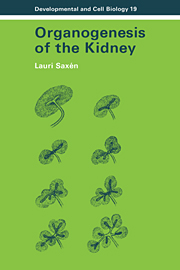Book contents
3 - Morphogenetic tissue interactions in the kidney
Published online by Cambridge University Press: 22 October 2009
Summary
Introduction
In Chapter 1, I described the development of the two major components of the metanephric kidney, the branching epithelium of the ureter and the mesenchyme converted into epithelial elements. The development of these two cell lineages occurs in a strictly controlled, temporally and spatially synchronous manner. Theoretically, such control could be achieved in two ways; either both tissue components are under the same organismal control system, ensuring the timing of development, or the two cell lineages become aware of each other by exchanging signals that co-ordinate their development. I believe that the two mechanisms are interacting and are both involved in organogenesis, as will be discussed in Chapter 4. Here I will focus on the local interaction of the epithelial and mesenchymal components of the kidney.
General background
A morphogenetically significant interaction between two tissue components was demonstrated by Spemann (1901, 1912), who transplanted an optic vesicle onto a heterotopic site in an amphibian embryo, thus stimulating the formation of an extra lens from the overlying epidermis. This ‘induction’ could be prevented by interposing some impermeable material between the optic vesicle and the epidermis. Subsequently the concept of ‘embryonic induction’ was developed, and it became established in the 1920s after the demonstration of the primary inductive events during gastrulation (for reviews, see Spemann, 1936; Saxén & Toivonen, 1962). We know now that the inductive system operates throughout embryogenesis, ‘whenever two or more tissues of different history and properties become intimately associated and alteration of the developmental course of the interactants results’ (Grobstein, 1956b).
- Type
- Chapter
- Information
- Organogenesis of the Kidney , pp. 51 - 87Publisher: Cambridge University PressPrint publication year: 1987



